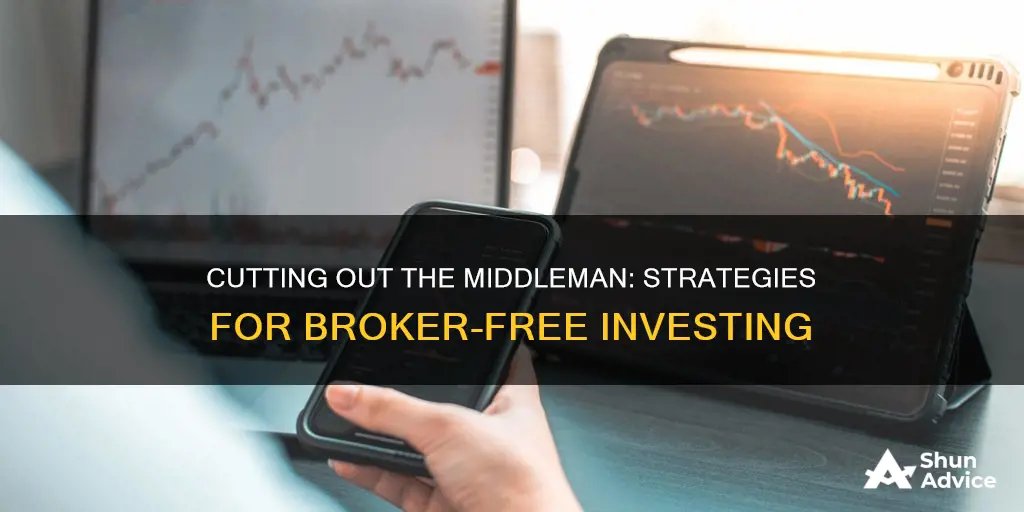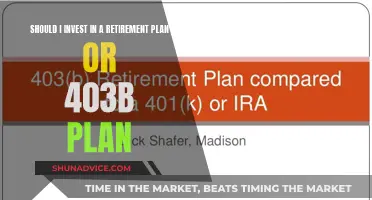
While a personal stockbroker can help you navigate the world of investing, they can also cost a lot of money in hidden fees. Fortunately, you can avoid these fees by investing without a broker. You can buy stocks directly from the company itself, known as a direct stock purchase plan (DSPP) or direct investment plan. Alternatively, you can open a dividend reinvestment account, where any dividends you earn are automatically reinvested to purchase more stock. Another option is to use an online brokerage account, which can be set up similarly to a bank account.
| Characteristics | Values |
|---|---|
| Type of trading account | Demat Account, Online Brokerage Account, DSPP, DRiP |
| Trading platform | Moomoo, Futu Inc |
| Orders | Market order, Limit order |
| Investment options | Stocks, bonds, mutual funds, IPOs, ETFs, futures, currencies |
| Investment research | Trade index volume, peer-to-peer company strengths, market news, liquidity, volatility |
| Investment budget | Determined by the investor |
What You'll Learn

Direct Stock Purchase Plans (DSPPs)
DSPPs offer a passive and automated experience for investors. They are a good option for those who want to avoid paying brokerage fees, and sometimes companies will even offer discounts on shares purchased through a DSPP. DSPPs are also a good option for investors who want to avoid their investment data being sold or shared improperly, as the plans are managed by the companies themselves or third-party transfer agents.
However, there are some drawbacks to DSPP investment. Firstly, they are not a good option for investors who want the agility of a broker or the short-term trading that a brokerage account allows. DSPPs also require investors to maintain their plans separately from other investment accounts, which can be inconvenient for those who like to manage all their investments in one place. DSPP shares are also illiquid, meaning it is very hard to sell them without the aid of a broker, so investors need to have a long-term strategy in place before investing.
Some other fees may also apply to DSPPs, such as account setup fees, transaction fees, or fees to sell. The price of each share is not equivalent to the market price, but rather the average price over a period of time, which can make it difficult for investors to time the market and sell at the optimal moment.
Nvidia: Buy or Bail?
You may want to see also

Dividend Reinvestment Plans (DRiPs)
DRiPs allow investors to compound their returns over time by accumulating more shares, which themselves pay dividends that can be reinvested. This is known as the effect of automatic reinvestment. When dividends are increased, shareholders receive an increasing amount on each share they own, which can also purchase a larger number of shares. Over time, this increases the total return potential of the investment.
There are several advantages of DRiPs for both the company issuing the shares and the shareholder. For investors, DRiPs offer a way to accumulate more shares without having to pay a commission. Many companies offer shares at a discount through their DRiP. Some companies also allow investors to purchase fractional shares, ensuring that every dividend dollar is used.
For companies, dividend-paying firms benefit from DRiPs as they create more capital for the company to use. Additionally, shareholders who participate in a DRiP are less likely to sell their shares when the stock market declines. This is because participants tend to be long-term investors and recognize the role their dividends play in the long-term growth of their portfolios.
There are some disadvantages to DRiPs. They may require minimums, such as a minimum number of shares to participate in the plan. Plans may also vary, so it's important to contact the company to find out the specifics. DRiPs also only invest in their own stock, so if investors want to use their dividend payment to buy a different stock, they have to do it themselves. There is also an inflexible reinvestment schedule, as DRiPs generally reinvest at the time a dividend is paid.
DRiPs are a good option for those who are uncomfortable with investing online, as they can be done via mail. However, given the inflexibility of DRiP plans and the flexibility and low cost of brokerages, many experts don't see the same advantages of DRiP plans that they used to.
Crypto Investors: How Many?
You may want to see also

Online Brokerage Accounts
One of the biggest advantages of online brokerage accounts is their low cost. Many such accounts charge nothing or very little to trade certain types of securities. However, it is important to be aware that companies advertising zero-commission trades may be compensated by market makers through "order flow", which can affect your profit, especially if you are an active trader.
With an online brokerage account, you have the freedom to invest in whatever you choose, as you own all the assets in your account. You can trade stocks, options, bonds, mutual funds, ETFs, and other financial products.
When choosing an online brokerage, it is important to familiarise yourself with the top online trading platforms and the controls they use. You should also consider the cost structure, the variety of funds available, and the educational resources on offer.
- ETRADE: One of the pioneers of online investing, ETRADE offers an excellent trading platform and a wide range of investment options.
- SoFi Active Investing: A modern, user-friendly platform that offers both a self-directed brokerage and a robo-advisor.
- Robinhood: A simple, user-friendly app-based trading platform that pioneered zero-commission stock trades.
- J.P. Morgan Self-Directed Investing: A low-fee platform offered by one of the largest financial institutions in the world, with an excellent app and $0 commissions.
- Fidelity: One of the largest and most well-rounded brokerages, offering $0 commissions for online stock and ETF trades, and a high-quality mobile app.
- Charles Schwab: A feature-packed platform with low fees, fractional shares, and excellent educational resources.
TSP Investments: Understanding the Distribution Dynamics
You may want to see also

Self-Directed Trading
Technically, you cannot buy stocks without a broker, but you can engage in self-directed trading by using a broker-dealer platform. This method of stock trading can help you avoid brokerage fees while still allowing you to participate in the stock market.
Step 1: Determine the type of trading account you want to use
Before you begin stock trading, you need to decide on the type of investment account you would like to use. If you want access to tools and resources to help you navigate your investments, consider using an online brokerage platform. Once you've made your selection, set up your account and transfer money from your bank account so you can start investing.
Step 2: Research the companies you want to purchase stocks from
Take your time to research and read about the different stocks you're interested in, including any recent business press releases and letters to shareholders. This can be overwhelming for those without a financial background, but there are resources available to help you.
Step 3: Determine your budget and pick a stock
If you plan to invest in multiple companies, consider how much of your budget you want to allocate to each. This will help you understand how much stock you can afford to buy from a given company. Keep in mind that some companies, especially if you use an online broker, will allow you to buy fractions of stock, which can be a great option for companies with high stock prices. Once you've determined your budget, it's time to pick a stock.
Step 4: Buy your stock
Now that you know what and how much you want to buy, make your purchase. If you use an online brokerage, you can typically track your investment using a single platform and stay updated on its performance. When you're ready to make your purchase, you will have a choice between two main orders: a market order and a limit order. Market orders are filled right away at the currently listed price, while limit orders are filled when the price reaches a certain point.
Apple: A Wise Investment Right Now
You may want to see also

Dollar-Cost Averaging
How Dollar-Cost Averaging Works
A prime example of dollar-cost averaging is its use in 401(k) plans, where employees invest regularly regardless of the price of the investment. With a 401(k) plan, employees can choose how much they wish to contribute and which investments offered by the plan to invest in. Investments are then made automatically every pay period. Depending on the markets, employees might see a larger or smaller number of securities added to their accounts.
Benefits of Dollar-Cost Averaging
Who Should Use Dollar-Cost Averaging?
The dollar-cost averaging strategy can be used by any investor who wants to take advantage of its benefits, which include a potentially lower average cost, automatic investing over regular intervals of time, and a method that relieves them of the stress of having to make purchase decisions under pressure when the market is volatile.
However, dollar-cost averaging isn't for everyone. It is not necessarily appropriate for those investing in periods when prices are trending steadily in one direction or the other. Be sure to consider your outlook for an investment, as well as the broader market, when deciding to use dollar-cost averaging.
Special Considerations
Using this strategy to buy an individual stock without researching a company's details could prove detrimental, as an investor might continue to buy more stock when they would otherwise stop buying or exit the position. For less-informed investors, the strategy is far less risky when used to buy index funds rather than individual stocks.
Who Pays for Investment Advice?
You may want to see also
Frequently asked questions
You can buy stocks without a broker by using a self-administered brokerage service or investing in a dividend reinvestment plan or a direct stock purchase plan.
Direct stock purchase plans allow investors to buy shares directly from the company, often with low or no fees. However, they may have higher upfront costs and require you to open a new account for each company you invest in.
Dividend reinvestment plans automatically reinvest dividends to purchase more stock. They can offer automated, compounded growth, but they are only offered by a limited number of companies.







